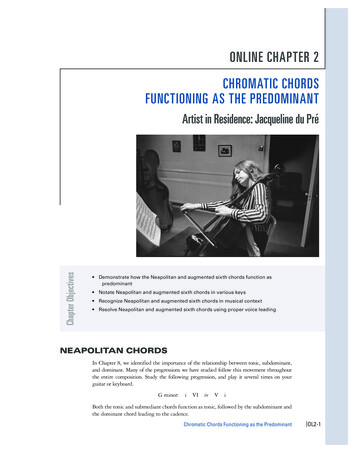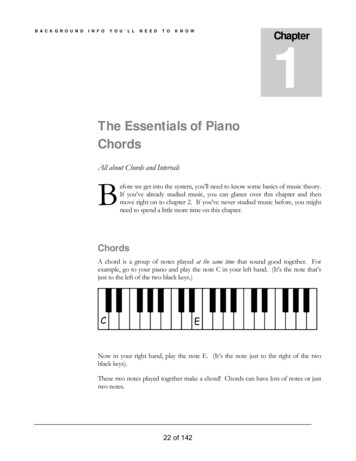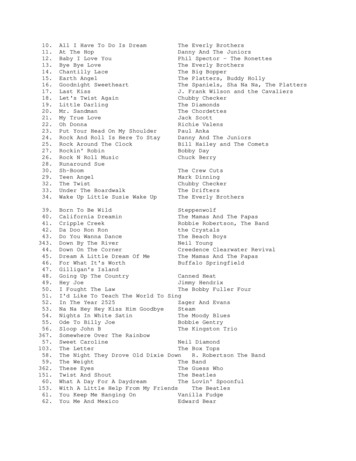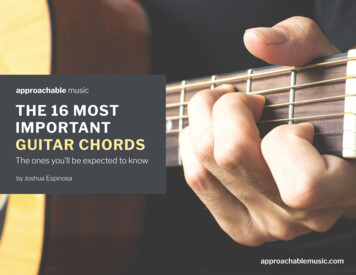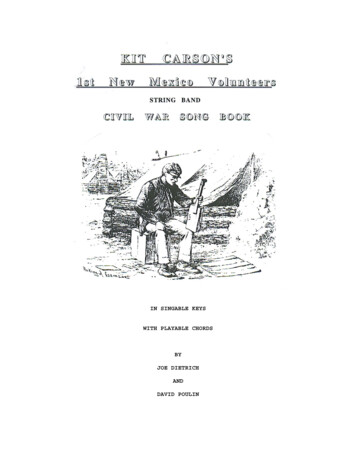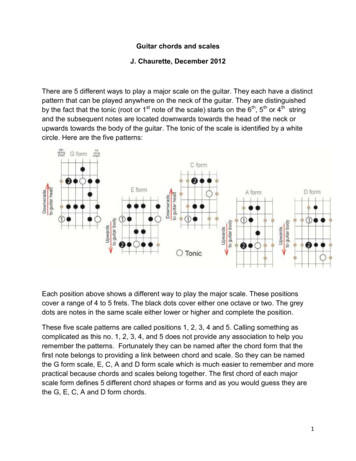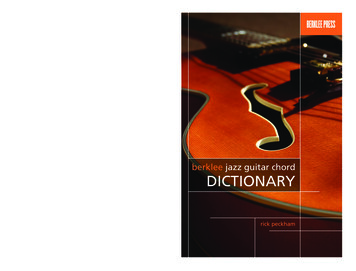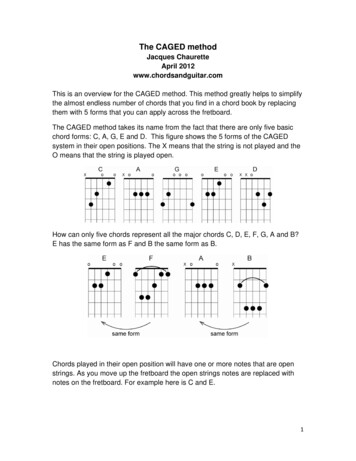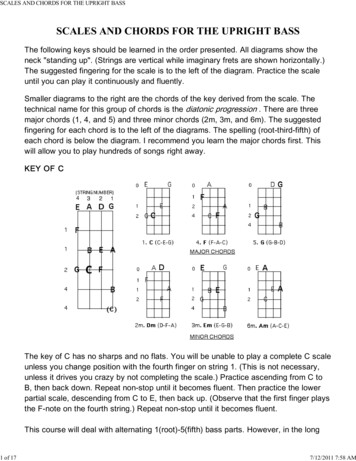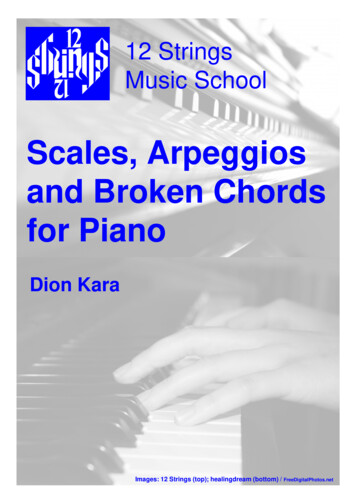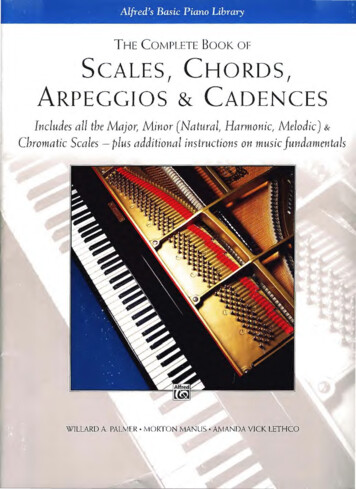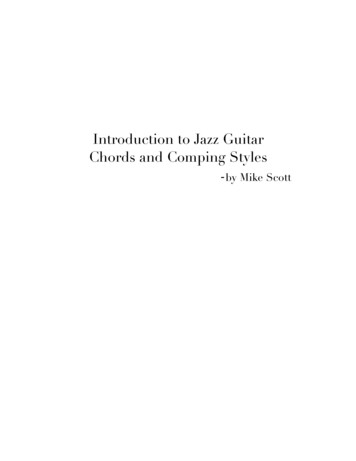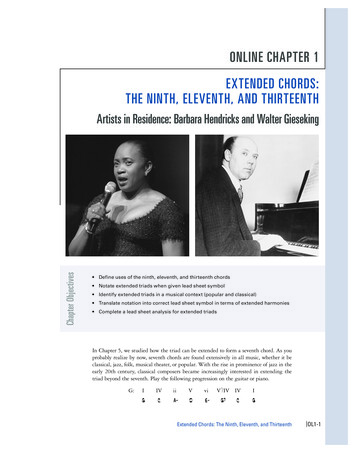
Transcription
ONLINE CHAPTER 1EXTENDED CHORDS:THE NINTH, ELEVENTH, AND THIRTEENTHChapter ObjectivesArtists in Residence: Barbara Hendricks and Walter Gieseking Define uses of the ninth, eleventh, and thirteenth chords Notate extended triads when given lead sheet symbol Identify extended triads in a musical context (popular and classical) Translate notation into correct lead sheet symbol in terms of extended harmonies Complete a lead sheet analysis for extended triadsIn Chapter 5, we studied how the triad can be extended to form a seventh chord. As youprobably realize by now, seventh chords are found extensively in all music, whether it beclassical, jazz, folk, musical theater, or popular. With the rise in prominence of jazz in theearly 20th century, classical composers became increasingly interested in extending thetriad beyond the seventh. Play the following progression on the guitar or piano.G:IIViiVviGCA-DE-V7/IV IVG7CIGExtended Chords: The Ninth, Eleventh, and Thirteenth OL1-1
By extending several of the triads to include ninths, elevenths, and thirteenths, theentire color of the progression is altered. Many times the added notes create unresolveddissonances, but it is important to note that the function of the chord does not change. Forinstance, the second subdominant chord would still function as a subdominant regardlessof the added notes. Let’s change the progression to include several common extendedchords. The pitches used in each extended chord are notated below the progression.G:G# ww& wIC maj 9IIVM9iiV13viGC maj 9A-D 13E-D 13wwwwwA-wwwwwwwwwwIVM9iiV13E-wwwviV7/IV IVM11 ICmaj 11G7G7n wwwwV7/IVGC maj 11wwwwwwIVM11GwwwIBACKSTAGE PASSEBSITEWThe Original Blurred Lines: ImpressionismVIDEOTR ACK 1By the late 19th century, the impressionistic movement was in full swing in both thevisual and musical art communities. Visual artists such as Monet and Renoir began toexperiment with colors, painting blurred lines to illuminate their masterpieces. In music,the clear structural components and functional harmonies that dominated the works ofcomposers in the 18th and 19th centuries gave way to ambiguity in both harmony andform. Composers writing during this era preferred to use extended triads, such as theninth, eleventh, and thirteenth chord, as a technique to create ambiguity in terms of function. Claude Debussy, one of the prominent composers of the era explains, “I love musicpassionately. And because I love it, I try to free it from barren traditions that stifle it. It isa free art gushing forth, an open-air art boundless as the elements, the wind, the sky, thesea. It must never be shut in and become an academic art.”When listening to the music or viewing a painting from this time period, you caneasily see and hear this “open-air art.” Take a few minutes to browse the Internet for a fewexamples of impressionistic art. As you are viewing the paintings, play La Mer by Debussyin the background. Do you feel a sense of blurring of the musical structure? Is the tonicpitch as clear as it once was in earlier music? How does this musical blending carry overinto the images you see?NINTH CHORDSAny seventh chord can be extended to become a ninth chord; however, it is most commonto see the ninth on the supertonic, subdominant, and dominant chord. Only three possible ninth chords—the diatonic ninth, lowered ninth, and raised ninth—exist in bothpopular and classical music. The example on the following staff illustrates all of thepossibilities for 9th chords built on the dominant, including lead sheet symbols. Unlessspecifically notated in the chord symbol, the extensions will all be diatonic in relation tothe key of the song or composition.OL1-2 Extended Chords: The Ninth, Eleventh, and Thirteenth
Play through the chords above on your keyboard or guitar. Which chord sounds themost dissonant? The raised ninth chord is used extensively in popular music and jazz,producing the dissonance of a half step between the third of the chord and the ninth. Thepitch E cannot be explained in the key of G major (or G minor) and is merely added ascolor to the dominant chord to create tension.In many lead sheet transcriptions, you may see the symbol Dadd9. Is this a true ninthchord? The answer is no. The lead sheet notation for Dadd9 would be a D major chord withan added E, again to create tension through an unresolved suspension. In order for a ninthchord to function as an extended triad, the seventh of the chord must be present.Another question you might ask is, why we simply don’t use the number 2 to show theaddition of the ninth? After all, the ninth is really the second scale degree above the root,right? It is important to note that the extended triad is just that: an extension of the triadand not an added pitch.Study the following chords in order to see common chord extensions. The extension ofthe ninth can be added to any type of seventh chord.D maj 9&www## wwD- 9wwwwwD9www# ww!D7 9b www# ww#D7 9# www# wwD ª9b wwwwwD μ9b b wwwwwARTIST IN RESIDENCEBarbara Hendricks:Curious Student, Scholar, Philanthropist, and ArtistThe home page of Barbara Hendricks’s website shows a striking African American womanwith the quote, “I was born curious.” How does this curiosity carry over into famous operasinger Barbara Hendricks’s professional life? Raised in a small town in Arkansas, Hendricks was determined to make something of herself. She studied both mathematics andchemistry in college before graduating at the age of 20! That in itself is a huge accomplishment, only to be eclipsed by her acceptance at Juilliard in the same year. After studying atJuilliard, Hendricks became one of the most sought after opera singers of her generation.In a quick glance at her discography, it is easy to see that Hendricks’s curiosity led her tostudy and perform in a wide variety of genres. She has made more than eighty recordingsof various works, including art songs, lieder, jazz, and opera.Hendricks has sung in the premier opera houses across the globe, but it is perhaps of herhumanitarian effort that she is the most dedicated and proud. In recognition of her commitment to serving refugees, in 2002 she was named Honorary Goodwill Ambassador for Life bythe United Nations Refugee Agency. According to the agency website, “In 1998 she foundedthe Barbara Hendricks Foundation for Peace and Reconciliation to personalize her strugglefor the prevention of conflicts in the world and to facilitate reconciliation and enduring peacewhere conflicts have already occurred.” Beyond her success in music, Hendricks is determinedto make the world a better place with her artistic performances and humanitarian efforts.Extended Chords: The Ninth, Eleventh, and Thirteenth OL1-3
EWListen to Hendricks’s performances of Fauré’s “Après un Rêve” (1877) and “ChansonD’amour” (1882) on the YouTube channel. Each chanson (French song) contains severalextended ninth chords, and each example provides excellent illustrations of impressionisticcompositional techniques. What is the harmonic function of the chords analyzed with leadsheet symbols? Pay careful attention to the difference between the extended triads and theadded note chords. Seventh chords are also used extensively in these two examples, so takea few minutes to complete a lead sheet analysis of each excerpt. How is Fauré’s use of theseventh chord different from that of, say, Mozart?EBSITVIDEOTR ACKS2 AND 3Barbara Hendricks, Fauré’s “Après un Rêve”G17& b 43 œœ9Cfœœœœ œ œ œ œ3Tum’ap - pe-lais& b 43 gg œœ œœœ œœœ œœœ œœœœ œœœœ œœœnœgg œgF? 3 .b 4 . . .&b œ21toiœJ nœ œvers laœœœœb 25&b œnous,3? b .b b .OL1-4 œœœœ3-œœœœœœœœ3bœrePour m’en - fuirœœœœœœœœœœœœen - tr’ou -vraient leursœœ #œœœ . . .pœre;Lesœœœœœœœœœœœœœœœœnu -es,Splenbœ-33ciuxpourjœ œ œ Jœœœ œœ œœ œœ œœ œœœ œ œ œ œ œ . .33œa - vecœœœ b œœ œœ œœ œœ b œœ œœœ œ œ œ œ œ œ . .œœœœœœœœœœœœ # œœœœ œœœœp . .œ œ œ#œ-œœœ œœ œœ œœœœ œœ œœ b œlu - mi蜜& b œœ œœ œœ œœ œœœ œ œ œ œterœ œ nœ œ œ œœœœ . .& b # œœ œœ œœ œœ œœ œœ œ œœ œ œ œ œ œ # œœœ œœœ? (add9)3et je quit- tais laœœœœEb9deursœ œ œ œ œ œœin - con - nu -œes,#œlu-œœ œœ œœœ œœœ œœœ œœœ b œœ œœ œœ œœ œœ # œœ œœ œœ œœ œœ œœ œœœ œ œ œ œ œ #œ œ œ œ œ œ# . Extended Chords: The Ninth, Eleventh, and Thirteenthœ .
cresc.29&b œ3eursjœ œ œ œ œ œ œ3di - vi3- nes en -œtrevu& b b œœ œœ œœ œœ n œœ œœœ œ œ œ œ œ?b œœ-es Hé# œœ œœ œœ œœ œœ œœœ œ œ œ œ œ œœœœTranslation: You called me and I left the earth to run away with you towards the light. The skiesopened their clouds for us, Unknown splendours, divine flashes glimpsed.Barbara Hendricks, Fauré’s “Chanson D’amour”G#3#dolceœ& cœœ œ J’ai - me tes yeus,#& c ‰ π# œœ œ &π?#11&#œœ ‰œ nœOma re - belle, ô ma fa - rou‰œ œœ ‰# œ œ œ.j nœœj’ai - me ta bouœœœœœ œ œ #œ œ œ œ‰œ‰œ n œœ-cheœœœœOù‰ -che,œ# œœ ‰ œ n œ # œ ‰ œ œœœœœ wsenza rigoreœJ’ai - me tes yeux,œ# 7# ‰j’ai - me ton front,œœ ‰œœ ‰ œ œœ ‰ œ œœœœœœœœ?# c &œ œ L 9 (no3rd)œ œ œ œ œ œa tempowmes bai- sers s’é - pui - se - ront.œœœœ ‰#nœœœ œœ œœœœœœœœœœœœœmarcato n b n œp J’ai-œ.œJmeta#œ œ œ œœ œ œ œœ œ œ œ ‰ œ œœ ‰ œ b œœœœœœœœœœœ œ œœœ œ pœ œ œ œ œ œ n ?# wwwœw&Extended Chords: The Ninth, Eleventh, and Thirteenth OL1-5
Barbara Hendricks, Fauré’s “Chanson D’amour” (continued)15&# bœœvoix,&# ‰? # b 19&# œô# ‰œ œ bœ bœœj’ai - me l’é - tran- geœ bœb œœ ‰Grâ - ceœœœ œ‰de tout ce que tu-ge,dis,O‰b n fjœ nœ bœ œ œœ nœ bœœ bœ œ.wbœ ‰bœbœ bœ n œ bœ œ œb n mon cher annœ œ nœ œ œ bœpoco a poco cresc.bœMon en - ferœœ n œœ‰œ œ ma re - belle,‰bœ ‰œbœ œ œ œ œb œœœbœœ # wet mon pa - ra - dis!œœ ‰ # œb œœ ‰ œ # œœ ‰ n œ b œœ ‰ b œ œœ ‰œœœœœ#œœœ#œ œFn ? # b n n # &Translation: I love your eyes, I love your forehead, oh my rebellious and fierce one.I love your eyes, I love your mouth on which my kisses will tire themselves out.I love your voice, I love the strange gracefulness of everything you say,oh my rebellious one, my dear angel, my hell and my paradise!ARTIST IN RESIDENCEWalter Gieseking: Master of the French StyleTo accurately perform the music of great French Impressionistic composers, one mightsay that the pianist needs to transport him or herself into a dreamlike state in order tocapture the flowing lines, extended harmonies, and parallel movement. Like a dancer onthe stage, the pianist must tell the story through the movements from pitch to pitch.Walter Gieseking is one such pianist who was able to capture the ambience of the FrenchImpressionistic style. According to author Mark Satola, Gieseking’s “finger acuity, imaginative pedaling, and above all, preternaturally alert ear made him an ideal interpreter ofthis music.” Gieseking’s performances were very well received—that is, until World War IIwhen the Allies accused him of buddying up to the Nazis. Because of this political conflict, his Carnegie Hall recital in 1949 was cancelled. However, as the dust settled acrossEurope, Gieseking’s name was cleared, and he enjoyed an excellent run on the recital circuit while still maintaining an active recording agenda. A quick scan of his discographyreveals many recordings of Bach and Beethoven, but it was his recordings of the Frenchcomposers for which he received the greatest accolades. David Dubal sums up Gieseking’splaying in his book The Art of the Piano:OL1-6 Extended Chords: The Ninth, Eleventh, and Thirteenth
[Gieseking] was a painter of music, and harmony was his color. He phrased with aunique pliancy coupled to a rhythmic awareness and a sense of forward motion. Nobodyhad ever brought to piano playing, especially in Debussy, such a feeling of inspiration, asense of evanescent sound hovering in midair, vulnerable to the slightest breeze.WVIDEOTR ACK 4Walter Gieseking, Debussy’s Prelude No. 4 from Book I, Op. 28Modéré ( q 84)(harmonieux et souple)œ b œœœœ bœ### 3œ& 4 Œ œœœ( 54 ) πŒ œœ œb n œœœœ? # # # 43œœ.7( b 9)F#-œœœŒŒŒŒœ.œ.b œ œœœœœœ œ bœœœœœœ œ bn œœœœ œœœ.œœ.œœ.œ.9BŒœ œ Œπ m.d.nœn b b œœœœ # n # n œœœœ b b n œœœŒŒnœ9B###Œ n œ n œ œ b œ œ n œ b œœ # œ. œ œœ.Œ nœ nœ œ bœ&œœœ œ ŒJ # œœ. œ. . m.d. n œ b œœbnb b n n œœœœ b ? # # # n œœœ n b œœœ # n # œœœœ b b n œœœ Œ œ ŒŒŒ Œ nœŒ Œ nœŒ nœ.4EBSITEListen to Gieseking’s performance of Prelude No. 4, Op. 28, by Claude Debussy. Theextended triads are labeled for you in the score below. Take a few minutes and try to complete a lead sheet analysis for the first two measures. Why would it be difficult to completea Roman numeral analysis for this piece?. n œœ. b œœ.œ.# œ n b œœ œœ œJ .Œ nœ.ŒEn animant un peu9&###œ #œ œ# Œ œ #œ œp m.d.# .? # # # n # . . .expressifœ œ œ #œ œ œœœ œ n œœ # œ œœ œœœœœn œœn œœœœœœœ œ œ Œ œ œ œpm.d.# .# . . .œœœœ œ n œœ œ œœ œœ œ œ œœœœœn œœn œœœœœœ.œŒ # œ œ œF- # œ œn .n .œ œŒ œ œ ‰J En. retenanta tempo. œégal et doux#œœ14.œœœ.œ###œ #œ œ‰ n œœ # œ œ # œ œ ‰ # œ œ œ œ œŒ Œ œ #œ œ&#œ#œ œ œ#œ œœ #œ œ #œp dim.πn .n œœ œœ .œ nœ? # # # # .#œn . &œœœ œ œ#œ#œœœŒ œ œ ‰ Œ œen dehorsJExtended Chords: The Ninth, Eleventh, and Thirteenthœœœœœ OL1-7
ELEVENTH AND THIRTEENTH CHORDSThe following chart shows the most common eleventh and thirteenth chords in the contextof G major/minor.1 It is important to note that not all chord members beyond the seventhneed to be notated in order to label the chord as an extended triad. Also, notice that thereis no diatonic eleventh added to the dominant seventh chord and the 11 is used instead.Why do you think that most composers opt for the 11?#D maj 11# www#& # wwwwwwwwwwb wwwwwD maj 13D μ 11# www# wwwwb b wwwww!D 7 13D 13D- 13www& # # wwwwwwwwwwwwww# wwwwb www# wwwwListen to Barbara Hendricks’s performance of Fauré’s “Automne” on the YouTube channel. The chords in measures 29 and 30 clearly outline C minor. (Fauré is certainly notusing one of the conventional six-four chords from chapter 8!) By measure 31, the harmonicrhythm speeds up, and a succession of seventh chords and triads push toward the finalcadence in measure 36. The triads notated in measures 34 and 35 are not extended triadsbec
Play the following progression on the guitar or piano. G: I G IV C ii A-V D vi E- G7 IV C I G V/IV7 Chapter Objectives ONLINE CHAPTER 1 EXTENDED CHORDS: THE NINTH, ELEVENTH, AND THIRTEENTH Artists in Residence: Barbara Hendricks and Walter Gieseking. OL1-2 Extended Chords: The Ninth, Eleventh, and Thirteenth By extending several of the triads to include ninths, elevenths, and
